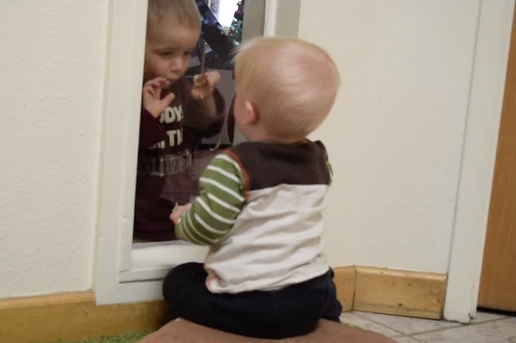Jun
23
Videatives Views #210 What is Glass?
 Does the boy in front of the glass think that the boy behind the glass expects him to take the tape? Bennett, inside the classroom, lifts the tape to Anders’s eye-level and sticks it to the glass (00:01, 00:10). Anders, in the corridor, reaches as if to touch the tape (00:02, 00:13). If the glass were a partition, easy to walk around, would Anders be prone to try to reach for the tape? Would he reach for the tape if it were pasted to the outside of a window overlooking the playground? Would he reach for the tape through the glass if it were pasted inside a large jar? Does Anders perhaps treat the window more like a door, with people on both sides?
Does the boy in front of the glass think that the boy behind the glass expects him to take the tape? Bennett, inside the classroom, lifts the tape to Anders’s eye-level and sticks it to the glass (00:01, 00:10). Anders, in the corridor, reaches as if to touch the tape (00:02, 00:13). If the glass were a partition, easy to walk around, would Anders be prone to try to reach for the tape? Would he reach for the tape if it were pasted to the outside of a window overlooking the playground? Would he reach for the tape through the glass if it were pasted inside a large jar? Does Anders perhaps treat the window more like a door, with people on both sides?
The social dimension likely causes the boy to reach for the tape. Bennett entices Anders by sticking the tape to the glass within his line of sight. The tape has been proffered, as a gift. It is suspended between the boys – out of Bennett’s hand, but not quite yet in Anders’ hand – stuck to the glass. It is more enticing to try to grab the tape when it is not in the other boy’s hand, but stuck to the glass – on it’s way to you. An object suspended on glass is more apparently graspable than an object in another child’s hand. It is also easier to grasp when the contour of the tape is not obscured by a person’s hand. Further, a young child like Anders has probably been conditioned to reach for things that are proffered by others (parents, caregivers, etc).
Bennett sticks the tape on the lower portion of the glass and watches as Anders tries to get it (00:17 – 00:22). Bennett might be wondering what Anders thinks he can do – speculating about his theory of mind. Notice how Bennett looks through the glass into Anders’ eyes (00:25) and suggestively points to the glass, near the tape (00:26). Bennett is a bit older and knows that one cannot reach through the glass. The act of sticking the tape affirms the glass as solid surface. Does he simply want Anders to mime the action of touching near the tape as a way to establish a relation, a game of pretense? Acoustically, the boys cannot hear each other. They can only speak in gestures. This sound isolation might provoke more focused sharing of an object because they cannot talk about it; they have to look at it.
If you look closely, you will notice that Anders tries to pinch the tape between two fingers (00:33, 00:52). Does this mean he literally is trying to grasp the tape, as opposed to playing a pretend game of "You touch - I touch"? He revises his strategy and swipes at the tape through the glass (00:34), perhaps thinking, “Okay, if I can’t pinch it off, maybe I can swipe it.” Note that Anders watches the tape drop down to the windowsill, as if he is waiting for it to come to rest before he picks it up (00:42). He reaches for the tape with his right hand and then switches to his left (00:47 -00:51). Anders is literally trying to get what has been offered to him. He is focused on what his hand has to do in order to get the tape - the instrumental act of “getting,” rather than the conditions of the environment - what is holding the tape up in mid air. Young children have not yet gotten to the point where the laws of nature are somewhat consistent – the laws of nature have to be constructed. An older child would realize that he was being invited to do something impossible. Anders does not yet know enough about the environment and likely assumes that he is not doing something right, so he continues revising his strategies. In this situation, the overwhelming affordances of the physical and social world mislead the child.
Later, Anders rubs the flat of the glass with the flat of his hand in a place away from the tape (00:55). With this action is he confirming, "This space is solid even though I can see through it"? It seems that he is trying to reconcile the contradictions of the glass. In swiping, his persistence leads to the accidental discovery that this space is solid.
Bennett works to sustain Anders’s engagement by “proffering” a new object – he presses the ring on his finger against the glass (01:06). Anders reverts to an earlier strategy, trying to pinch the ring between his fingers (01:09). Bennett focuses on the ring and holds it at Anders’ level as if to say, “Go ahead and see if you can grab it.” By pressing his face to the glass (01:24) Anders affirms how impenetrable the space is, and he comes closer to the full realization that he is never going to get what the other boy has.
The suggestion that Anders has entered into a game of pretense appears unlikely when you see his facial expression at time code 01:27. He places his hands on the sides of the window, not on the glass, as if to say, “Okay, I know what you’ve got, but it’s behind the glass.” Anders no longer tries to get the ring, realizing that the window glass is impenetrable. Bennett persists, making eye contact with Anders as he holds up the ring and points to it (01:32). The ring is not as evocative as the tape. The ring is not a proffered gift like the tape, because it is already possessed – the ring is on Bennett’s finger.
Certainly the social dynamics of two boys behind the glass attract Anders and help sustain his attempts to receive their offerings and participate in their other social cues of engagement. Bennett re-establishes eye contact with Anders, mouths something to him, and smiles (01:47). The second boy taps his toy horse against the glass (02:08) in an effort to re-activate Anders’ attention. His strategy is affirmed as Anders tilts his head back to look up (02:11). Once again, Bennett sticks the tape to the glass. This time, Anders only points at the tape (02:23) and does not try to pinch it. Anders has learned that he cannot grab the tape but “he can note it.” He has gone from thinking, “I can get it” to “It is there,” which logically implies, “It is there, but I cannot get it.”
It would be interesting to arrange other setups of attractive objects on the other side of a transparent barrier. We might do this just to understand the intellectual challenge of any child dealing with such paradoxical spaces. But such variations in setups would also help us recognize how a newly formed concept (solid see-through spaces) are initially not so robust that they can explain away the misleading affordances of the physical and social context. Here is a list of some of these affordances:
1. The glass is cut in a wall from room to corridor and more likely is read as a passage, not as something to let in the sun from the outside.
2. The boys in the glass are soliciting the boy in the corridor to "play a game" of touch the tape, but they are not socially in the room to help frame the game as pretense.
3. The tape is "suspended" in midair (stuck to the glass) and thereby provokes a reaching response, even more so than an object resting on an opaque surface like a table.
4. The glass barrier has no navigable path around it to the other side, so what else is the boy in the corridor to do?
5. The boy in the corridor sees the boy in the glass touching and moving the tape. Thus the boy in the corridor concludes, "If he can do it, I should be able to do it too."
The context of a problem determines its difficulty because sometimes the context leads one down a path of wrong expectations. Children continually have to add conditions to the concepts that they learn, conditions that lead to exceptions to the rule and conditions that lead to a response bias that has to be resisted. The beauty of life follows from the fact that children are learning to extend their concepts every minute of their waking days during spectacular ordinary moments.


